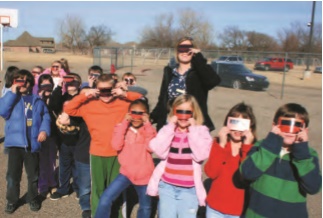Prepare Your Students for the August 21 Solar Eclipse with Solar Science
By Carole Hayward
Posted on 2016-02-02
Great extras accompany this book, including safety glasses for viewing the eclipse and an Observer’s Guide to the All-American Total Solar Eclipse.
“On Monday, August 21, 2017, a total eclipse of the Sun will be visible in the continental United States for the first time in almost 40 years. A total eclipse is when the Sun is completely hidden by the Moon, the sky becomes dark, and the Sun’s faint atmosphere (corona) becomes visible—looking like a beautiful halo. This total eclipse will only be visible on a narrow track stretching across the United States from Oregon to South Carolina. No other country will get to see the total eclipse this time.”
To help prepare middle schoolers for an optimum experience of this wondrous event, NSTA Press has published a great resource: Solar Science: Exploring Sunspots, Seasons, Eclipses, and More. This curriculum resource is written specifically to align with the three-dimensional (3D) learning encouraged by the Next Generation Science Standards (NGSS). Its learning experiences engage students in using real data to learn solar science and effectively integrate the Disciplinary Core Ideas (DCIs), Science Practices (SPs), and Crosscutting Concepts (CCC) associated with solar astronomy at the middle school level.
 Authors Dennis Schatz and Andrew Fraknoi are award-winning experts in astronomy and science education. Schatz is the Senior Advisor at the Pacific Science Center, and Andrew Fraknoi is the Chair of the Astronomy Department at Foothill College. Both authors regularly lead local and national professional development sessions for teachers at many different levels.
Authors Dennis Schatz and Andrew Fraknoi are award-winning experts in astronomy and science education. Schatz is the Senior Advisor at the Pacific Science Center, and Andrew Fraknoi is the Chair of the Astronomy Department at Foothill College. Both authors regularly lead local and national professional development sessions for teachers at many different levels.
They paired up to write this book because they know there will be tremendous interest in the eclipse and that teachers will want to prepare their students to understand relevant science topics the year before and the year after.
The 45 classroom-tested, hands-on, inquiry-based activities are organized into four sections
- Understanding and Tracking the Daily Motion of the Sun: What does the Sun do in the sky each day, and how does that relate to our notions of time and direction?
- Understanding and Tracking the Annual Motion of the Sun and the Seasons: How does the Sun’s motion and position in the sky vary throughout the year, and how does that relate to our ideas of a calendar and the seasons?
- Solar Activity and Space Weather: What phenomena do we observe on the surface and in the atmosphere of the Sun, and how do these influence what we observe and how we live our lives on Earth?
- The Sun, the Moon, and the Earth Together: Phases, Eclipses, and More: How do the relationships among the Earth, the Moon, and the Sun produce solar and lunar eclipses?
Ideally suited for teachers, informal science educators, youth group leaders, curriculum specialists, and teacher trainers, these versatile activities can be used one at a time, as the basis of a stand-alone unit on the Sun, or as a comprehensive curriculum.
Whether or not you buy a copy of Solar Science, you can download a free observing guide for the upcoming solar eclipse to share with students and their families as well as community partners. This eight-page guide includes everything you need to know regarding where and when to see the eclipse, how to observe the eclipse safely, and how to understand and explain what causes it.
NSTA Press has developed many online extras, including downloadable worksheets and charts to accompany lessons. This book is also available as an e-book.
Disclaimer: The views expressed in this blog post are those of the author(s) and do not necessarily reflect the official position of the National Science Teaching Association (NSTA).


